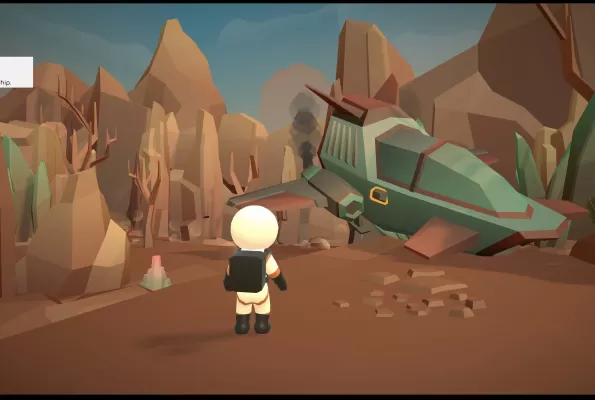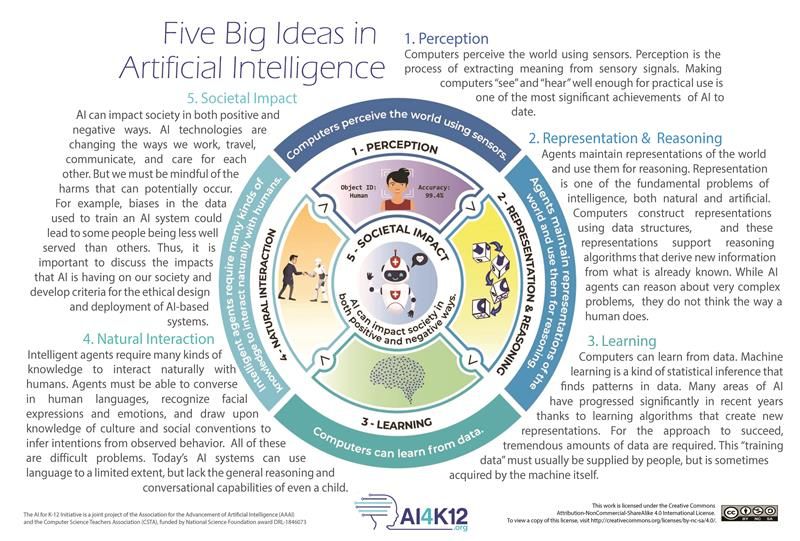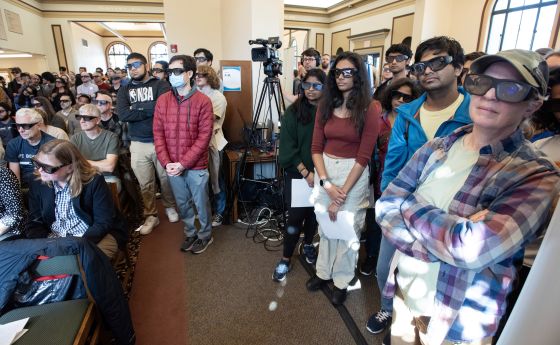
AI education and AI in education
Recent news headlines of students using generative artificial intelligence tools such as ChatGPT to write term papers may be what comes to mind for some when thinking about how AI is being introduced in classrooms. But it isn’t the only story to tell about AI in education – or education on AI.
AI is transforming how students learn to engage with the world around them and use new technologies to create solutions to real problems.
Researchers in California have developed an award-winning online game to teach high school students university-level AI and computational thinking concepts. Another team of researchers in California are using AI to teach AI with activities facilitated by a virtual human AI avatar meant to engage young children and their families in learning about AI concepts. On the other side of the country, middle school students in Maine starting their fall semester will soon look at the capabilities of an AI bird feeder that will be placed in their schoolyard before diving into AI or historical data set projects about puffins living off the coast of Maine.
These are only three projects among many that have received grants from the U.S. National Science Foundation in the last several years, and the number grows larger by the day.
NSF leadership in AI for education
“For more than 30 years, NSF has both led and invested in AI research projects to support, reimagine, and transform learning and teaching with the use of emerging technologies,” says James L. Moore III, NSF assistant director for STEM education. “Through NSF-funded research, we are learning how to harness AI to make education more equitable, inclusive, and accessible.” These research projects include helping the nation understand what AI means for the future of education, how it can benefit classrooms, including students, teachers, and parents, and what methods are best to inspire, engage, and teach future generations about AI.
“NSF has been leading the AI frontier, not chasing it,” said Chia Shen, a program officer in NSF’s Directorate for STEM Education. “We have a rich portfolio in this area with a strong impact. This is part of how we as an agency help the nation and the issues we have with AI like ethical issues, and biases; it’s not just about ChatGPT.”
In fact, in 2019, an NSF-funded project led to the development of national guidelines for teaching and learning about AI in K-12 school settings. Prior to this, there were few to no curriculums in the U.S. dedicated to teaching young, pre-college students about the fundamental knowledge and skills related to AI. Now educators and curriculum developers can visit the AI for K-12 initiative website to find guidelines. Teachers can use these to develop instructional experiences in AI for their students to better prepare them for the rapidly growing field.
Interactive AI exhibits
NSF-funded resources can also introduce younger learners to AI. Researchers at the University of Southern California Institute for Creative Technologies and the University of California, Berkeley, Lawrence Hall of Science are designing an interactive AI exhibit tailored to elementary-aged children. AI concepts are generally taught in college and graduate level courses, so researchers had to come up with new, accessible ways for children to engage with the exhibit effectively.
The researchers also had to keep in mind that children often have shorter attention spans and must be presented with new information in quick, easily digestible lessons. With that in mind, the research team developed several interactives that break down complex AI concepts into a series of more digestible activities. The activities include small games wherein a child is asked to help the virtual human AI avatar perceive, learn, reason and plan. For example, children can interact with a virtual human that tries to interpret which facial expressions they are making. Children can also guide a virtual human avatar through the task of cleaning up a cafeteria by identifying specific steps it needs to take.
In addition to conveying these complex concepts, researchers also want to spark curiosity about how AI works.
From the exhibit, researchers also discovered a few unexpected things. Ari Krakowski, director of the Center for Transforming Science and Society, noticed museum visitors and their families getting excited about the human aspect of AI. When children were engaging with the activity wherein the virtual human AI avatar is meant to determine what facial expression the visitor is making, parents and older siblings began to get involved as well and learn together through the experience.
“There was this joy and interconnectedness in the room,” said Krakowski.
Games that teach AI concepts
Ning Wang, a research associate professor at USC who worked on the "Virtual Human" exhibit, worked on another NSF project that began with a desire to teach AI concepts to younger audiences through a gaming platform. This ended up having more profound impacts than she initially planned.
The game, ARIN-561, provides players with the opportunity to explore a strange new planet as a crash-landed astronaut. Through a well-paced tutorial and AI transfer module, players begin the game by learning about common methods used in AI called classical search algorithms by testing different possible routes to save their wayward robot friend.
Before making the game widely available, students across the country were able to test it alongside other educational games to pick a winner of the Interservice/Industry Training, Simulation, and Education Conference Student’s Choice Award. In that process, the research team learned that two students who were recent refugees from Ukraine had taken the game home and began using it to learn English. Because the students were previously familiar with the topic, they could learn the language through the dialogue of the game and then talk about the shared experience with their classmates. “I don’t know if we could have wished for a better response from the students,” Wang said.
AI helping students connect with local environments
AI in education doesn't just help students improve computational thinking skills in the classroom. It can also create new ways to connect learners with their local environments, allow them to think critically about ecological problems, and aid them in coming up with realistic solutions.
This fall, middle school students in Maine will use an AI bird feeder set up in their schoolyard to learn how the machine captures, transmits and identifies images of birds that stop by for a visit. For example, they will learn how often the AI correctly identifies each bird and what leads to incorrect identifications. From there, students will be able to jump from birds at their school to the puffins captured on cameras placed on islands off the coast of Maine. Researchers watching those cameras realized that they couldn’t observe the puffin burrows 24/7, but, with the help of AI, they could capture significantly more data and images of the birds and their babies.
Students won’t be able to interact with the cameras and its AI capabilities just yet, but Penny Noyce, a science education leader and principal researcher on the project, said, “It will be interesting to see if some of the kids latch onto either birding or AI as a result of this. Birding is a way that non-scientists remain involved in science throughout their lives.”
It is easy to see from these examples that the interaction between AI and education goes far beyond how students might use ChatGPT. AI allows students at all grade levels to interact with the world around them, learn about themselves and other people and explore STEM in new ways. NSF is dedicated to continuing to fund projects researching the impact and possibilities of AI inside and outside of the classroom.






